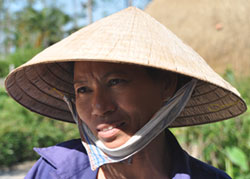News
Facing the Floods: Women Cope With Climate Change in Viet Nam
- 16 November 2009
News
QUANG TRI PROVINCE, Viet Nam — Life has never been easy for Nguyen Thi Lanh, 51, and Nguyen Duc Phi, 52. After enduring years of war, they married in 1977 and a year later had their first baby. “We were very poor at that time,” Lanh explains. “My husband had to take care of his family because his mother had died. We hardly had rice to feed our child, and we had to rebuild our house, which had collapsed during the war.”
Still, they persevered, managing to raise four children. But hardship remains, with erratic weather adding more stress to their lives year after year.
Viet Nam, with some 3,500 kilometres of coastline and large populations concentrated in low-lying delta regions, is especially vulnerable to the effects of climate change. Storms have become more intense and frequent, and the storm season now lasts longer. Ketsana, the typhoon that hit the country in late September, affected 3 million people, causing 163 deaths, 10 of which were in Quang Tri, and nearly $800 million in economic losses. Typhoon Mirinae, which struck Viet Nam in November, claimed about 100 lives.
The toll taken by extreme weather began at least a decade ago, recall Lanh and Phi, referring to the 1999 floods. “We lost our rice, our pigs and chickens, everything. The water came up to the window. The flood came suddenly, and we could not prepare anything in advance,” Phi says. “We moved to the temple, looking for shelter. We did not have time to take our belongings, just the clothes we were wearing,” Lanh says.
In recent years, rains have become unusually heavy, making it impossible for farmers to plant on time, and harvests have therefore been smaller. Climate change has already had an impact on Viet Nam, says Dr. Tran Thuc of Vietnam’s Ministry of Natural Resources and Environment. “More high intensity typhoons have occurred during the last few years.”
Viet Nam now feeds its 86 million people, and its abundant rice exports have earned it the title of “Asia’s rice basket.” But if sea levels rise as much as one metre, 40 per cent of the fertile Mekong Delta in the south will be under water.
And climate change is changing Lahns’ life for the worse. “Now we have to work harder because there often are floods, and we are afraid that in the future the situation will be even worse,” she says. She’s not alone – women, especially those in poor countries – are among the most vulnerable to climate change, according the State of World Population 2009 report released by UNFPA, the United Nations Population Fund, on 18 November. The report, Facing a changing world: Women, population and climate, discusses the different ways in which climate change could amplify inequities between men and women.
In Viet Nam and in many other countries affected by climate change, men migrate to the cities in search of jobs, while women are usually left behind to take on all the responsibilities for their households, often including planting and harvesting, taking care of livestock and providing for their families.

“When my husband is not at home, I have to work in the field. And in order to pay the school fees, I work extra time in construction, even though I am not in good health,” Lanh says, adding that she does her best to remain prepared for floods. Her home, like many in the area, has raised lofts so she can move belongings to higher places and keep the children safe when the waters rise, she explains.
Lanh – and many other women in Quang Tri – accept the idea that climate change is here to stay. They know that weather is no longer predictable and that flooding can happen almost any time. She and her neighbours participate in meetings and workshops organized once or twice per month by the Women’s Union in Hai Ba Commune, where climate change and natural disasters are recurrent topics. The villagers carry out evacuation drills, discuss emergency preparations and receive first aid training. It’s a chance for women to share their experiences on how to protect themselves, their families and their livelihoods during the flood season.
“Women are certainly bearing a disproportionate burden of the negative impact of climate change,” says Bruce Campbell, UNFPA’s representative in Viet Nam. “They also have the best first-hand knowledge and experience in dealing with and adapting to poverty and climate change,” he adds. “Therefore, we have to bring their wisdom to the table. It is more than being beneficiaries; we need to see women leading the discussion and the climate change policy debate.”
— Reported by Maria Larrinaga, with support from Oxfam Viet Nam